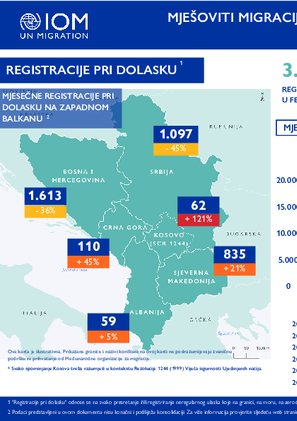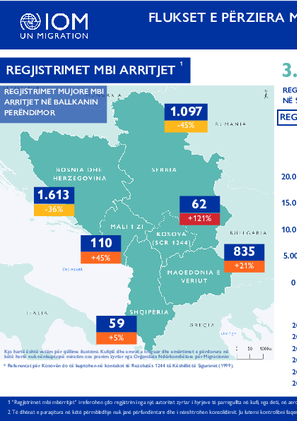-
Countries
-
Data and Analysis
-
Special Focus
-
Crisis Responses
Flow Monitoring
Domain host
migration.iom.int

Contact
DTMAfghanistan@iom.int
Language
English
Location
Afghanistan
Period Covered
Mar 03 2024
Mar 09 2024
Activity
- Survey
- Flow Monitoring Survey
- Flow Monitoring
In response to recent movements, IOM Afghanistan re-launched its DTM Flow Monitoring activity at the beginning of 2024 to better understand the mobility dynamics at Afghanistan’s borders. On 10 January 2024, DTM began deploying field teams at four border crossing points with the Islamic Republic of Iran (IRN) and Pakistan (PAK), expanding to another border crossing point Ghulam Khan as of 11 February (see map below for the locations of all five crossing points), to conduct two interlinked exercises. The first is a headcount of all individuals entering or leaving Afghanistan (including returnees), also called Flow Monitoring Counting (FMC), to gauge flow volume. The second is a survey of randomly selected Afghan national individuals or groups entering or leaving Afghanistan, also called the Flow Monitoring Survey (FMS), to understand the profiles, motivations, and vulnerabilities of the target population. This snapshot provides key findings combining various IOM data sources, including DTM Afghanistan’s FMC and FMS activities, DTM Pakistan’s Flow Monitoring of Afghan returnees, and IOM Afghanistan’s Cross-Border Post-Arrival Humanitarian Assistance (CB-PAHA) program, for the period 3 to 9 March 2024. For more information about methodology, see the the section in the last page of this report titled “IOM INFLOW DATA.”
The file contains the following sheets
| Sheet | Content | Countries and Areas |
| Summary | Summary figures on mixed migration flows by sea and by land, by country and by route | BGR, CYP, GRC, ITA, MLT, ESP ALB, BIH, HRV, MKD, MNE, ROU, SRB, SVN, XKX* |
| First_Arrival_Countries_Monthly | Monthly figures of arrivals by sea and by land, by country, by route | BGR, CYP, GRC, ITA, MLT, ESP |
| Other_Countries_Areas_Monthly | Monthly figures of arrivals by sea and by land, by country | ALB, BIH, HRV, MKD, MNE, ROU, SRB, SVN, XKX* |
| First_Arrival_Countries_CoO | Monthly figures of arrivals by country of origin, by country, by route | BGR, CYP, GRC, ITA, MLT, ESP |
| Other_Countries_Areas_CoO | Monthly figures of arrivals by country of origin, by country | ALB, BIH, HRV, MKD, MNE, ROU, SRB, SVN, XKX* |
| All_Daily Breakdown | Daily arrivals by sea and by land, by country | BGR, CYP, GRC, ITA, MLT, ESP ALB, BIH, HRV, MKD, MNE, ROU, SRB, SVN, XKX* |
| All_Migrants Presence | Migrant presence in reception centers, by country | BGR, CYP, GRC, ITA ALB, BIH, HRV, MKD, MNE, ROU, SRB, SVN, XKX* |
| Sources | Sources by country and data series | |
| ISO3 | List of countries and areas names, and their ISO code 3-digits |
Population Groups
Migrants Present
Other
Refugees/Asylum Seekers
Survey Methodology
Unit of Analysis Or Observation
Individual
Type of Survey or Assessment
Keywords
Contact
IOM DTM Yemen, iomyemendtm@iom.int
Location
Yemen
Activity
- Flow Monitoring
- Mobility Tracking
- Baseline Assessment
Period Covered
Feb 01 2024 -Feb 29 2024
In February 2024, IOM Yemen DTM recorded 1,744 migrants entering Yemen, an increase of less than one per cent compared to last month (1,737). Shabwah typically serves as an entry point for migrants from Somalia and rarely sees migrants departing from Djibouti due to the considerable distance between Djibouti and Shabwah. Thus, Shabwah was the arrival destination for all migrants departed from Bari, Somalia (1,744). The overall number of migrants entering through Shabwah has increased by less than one per cent in February (1,744) compared to January 2024 (1,736).
According to DTM, conflict-induced movements constituted 56 per cent of all incoming movements in February 2024. These movements were exclusively observed in Shabwah, originating from Bari, Somalia (22% children, 21% women, and 58% men).
DTM observed a decrease in Yemeni returnees by 39 per cent in February (3,116) compared to January (5,148). This decrease might be attributed to the fact that more people travel to the Kingdom of Saudi Arabia annually to perform the Omrah during the months of Sha'aban and Ramadan. This results in heavy crowding at Al-Wadea'ah land border and causes the Saudi authorities to concentrate more on those entering the country irregularly than on the process of deportation.
The deteriorating humanitarian crisis in Yemen has forced many migrants to make the difficult decision to return to their home countries in the Horn of Africa. Others are reported to have been deported by authorities. DTM recorded that in February 2024, a total of 2,326 migrants either opted to take the risky journey back or were deported by boat from Yemen. This group consisted of 92 per cent men, 4 per cent women, and 4 per cent children.
Additionally, the Djibouti DTM team documented that during the same period, 1,730 migrants (1,570 males and 160 females) embarked on a dangerous journey back home by boat from Yemen. These numbers highlight the significant challenges faced by migrants in Yemen and the desperate situations that have driven them to undertake perilous voyages across the sea.
Population Groups
Survey Methodology
Unit of Analysis Or Observation
Type of Survey or Assessment
Keywords
Geographical Scope
Administrative boundaries with available data
The current dataset covers the following administrative boundaries

Contact
IOM DTM Yemen, iomyemendtm@iom.int
Language
Arabic
Location
Yemen
Period Covered
Feb 01 2024
Feb 29 2024
Activity
- Flow Monitoring
- Mobility Tracking
- Baseline Assessment
يقوم سجل مراقبة التدفق التابع لمصفوفة تتبع النزوح (FMR) التابع للمنظمة الدولية للهجرة في اليمن بمراقبة وصول المهاجرين على الحدود الساحلية الجنوبية ومواقع العودة اليمنية على الحدود الشمالية لليمن مع المملكة العربية السعودية. يقوم القائمون على التعداد الموجودون في نقاط مراقبة التدفق بتسجيل المهاجرين الوافدين والمواطنين اليمنيين العائدين لتحديد أنماط الهجرة المختلفة، ولتقديم تقديرات كمية للمساعدة في تحديد عدد المهاجرين غير الشرعيين الذين يدخلون البلاد.
لا تمثل الهجرة القسرية جميع التدفقات في اليمن وينبغي فهمها على أنها مؤشر فقط لاتجاهات الهجرة للعدد الإجمالي غير المعروف للمهاجرين الذين يصلون إلى اليمن عند نقاط الهجرة خلال الإطار الزمني المحدد. تحد قيود الوصول من القدرة على جمع البيانات في بعض نقاط وصول المهاجرين.
وفي محاولة للحد من تدفق المهاجرين الداخلين إلى اليمن، والذي يعبر البلاد بشكل أساسي متجهاً نحو المملكة العربية السعودية ودول الخليج الأخرى، بدأت حملة عسكرية مشتركة في أغسطس 2023. ركزت هذه الحملة على ساحل محافظة لحج، نقطة دخول مهمة لعدد كبير من المهاجرين (بحد أقصى 15,714 مهاجرًا في مارس 2023). احتجز الجيش المهربين وطارد قواربهم، مما أدى إلى انخفاض مطرد في تدفق المهاجرين عبر هذا الساحل حتى توقف تماما خلال الأشهر الخمسة الماضية، مع استثناء واحد في منتصف ديسمبر/كانون الأول 2023 عندما تمكن قارب يحمل 110 مهاجرين من الوصول إلى الساحل. أرض.
في فبراير 2024، سجلت مصفوفة تتبع النزوح التابعة للمنظمة الدولية للهجرة في اليمن دخول 1,744 مهاجرًا إلى اليمن، بزيادة أقل من واحد بالمائة مقارنة بالشهر الماضي (1,737). تعتبر شبوة عادة نقطة دخول للمهاجرين من الصومال ونادرا ما تشهد مغادرة المهاجرين من جيبوتي بسبب المسافة الكبيرة بين جيبوتي وشبوة. وهكذا، كانت شبوة وجهة الوصول لجميع المهاجرين المغادرين من باري، الصومال (1,744). ارتفع العدد الإجمالي للمهاجرين الذين يدخلون عبر شبوة بنسبة أقل من واحد في المائة في فبراير (1,744) مقارنة بشهر يناير 2024 (1,736).
وفقًا لمصفوفة تتبع النزوح، شكلت الحركات الناجمة عن النزاع 56% من جميع الحركات الواردة في فبراير 2024. وقد لوحظت هذه الحركات حصريًا في شبوة، مصدرها باري، الصومال (22% أطفال، 21% نساء، 58% رجال).
ولاحظت مصفوفة تتبع النزوح انخفاضاً في عدد العائدين اليمنيين بنسبة 39 بالمائة في فبراير (3,116) مقارنة بشهر يناير (5,148). وقد يعزى هذا الانخفاض إلى تزايد أعداد المسافرين إلى المملكة العربية السعودية سنويا لأداء العمرة خلال شهري شعبان ورمضان. ويؤدي ذلك إلى ازدحام شديد على حدود الوديعة البرية، ويجعل السلطات السعودية تركز أكثر على الداخلين إلى البلاد بطريقة غير نظامية أكثر من التركيز على عملية الترحيل.
أجبرت الأزمة الإنسانية المتدهورة في اليمن العديد من المهاجرين على اتخاذ القرار الصعب بالعودة إلى بلدانهم الأصلية في القرن الأفريقي. وبحسب ما ورد قامت السلطات بترحيل آخرين. سجلت مصفوفة تتبع النزوح أنه في فبراير 2024، اختار ما مجموعه 2,326 مهاجرًا إما القيام برحلة العودة المحفوفة بالمخاطر أو تم ترحيلهم بالقوارب من اليمن. وتتكون هذه المجموعة من 92 في المائة رجال، و4 في المائة نساء، و4 في المائة أطفال.
بالإضافة إلى ذلك، وثّق فريق مصفوفة تتبع النزوح في جيبوتي أنه خلال الفترة نفسها، انطلق 1,730 مهاجرًا (1,570 ذكرًا و160 أنثى) في رحلة خطيرة للعودة إلى وطنهم بالقوارب من اليمن. تسلط هذه الأرقام الضوء على التحديات الكبيرة التي يواجهها المهاجرون في اليمن والأوضاع اليائسة التي دفعتهم إلى القيام برحلات محفوفة بالمخاطر عبر البحر.
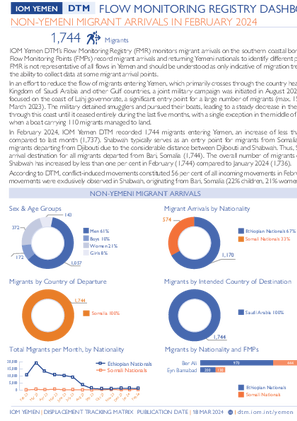
Contact
IOM DTM Yemen, iomyemendtm@iom.int
Language
English
Location
Yemen
Period Covered
Feb 01 2024
Feb 29 2024
Activity
- Flow Monitoring
- Mobility Tracking
- Baseline Assessment
IOM Yemen DTM’s Flow Monitoring Registry (FMR) monitors migrant arrivals on the southern coastal border and Yemeni return locations on Yemen's northern border with the Kingdom of Saudi Arabia (KSA). Enumerators placed at Flow Monitoring Points (FMPs) record migrant arrivals and returning Yemeni nationals to identify different patterns of migration, and to provide quantitative estimates to help define the population of irregular migrants entering the country.
FMR is not representative of all flows in Yemen and should be understood as only indicative of migration trends of the unknown total number of migrants arriving in Yemen at FMPs during the time frame indicated. Access constraints limit the ability to collect data at some migrant arrival points.
In an effort to reduce the flow of migrants entering Yemen, which primarily crosses through the country heading towards the Kingdom of Saudi Arabia and other Gulf countries, a joint military campaign was initiated in August 2023. This campaign focused on the coast of Lahj governorate, a significant entry point for a large number of migrants (max. 15,714 migrants in March 2023). The military detained smugglers and pursued their boats, leading to a steady decrease in the flow of migrants through this coast until it ceased entirely during the last five months, with a single exception in the middle of December 2023 when a boat carrying 110 migrants managed to land.
In February 2024, IOM Yemen DTM recorded 1,744 migrants entering Yemen, an increase of less than one per cent compared to last month (1,737). Shabwah typically serves as an entry point for migrants from Somalia and rarely sees migrants departing from Djibouti due to the considerable distance between Djibouti and Shabwah. Thus, Shabwah was the arrival destination for all migrants departed from Bari, Somalia (1,744). The overall number of migrants entering through Shabwah has increased by less than one per cent in February (1,744) compared to January 2024 (1,736).
According to DTM, conflict-induced movements constituted 56 per cent of all incoming movements in February 2024. These movements were exclusively observed in Shabwah, originating from Bari, Somalia (22% children, 21% women, and 58% men).
DTM observed a decrease in Yemeni returnees by 39 per cent in February (3,116) compared to January (5,148). This decrease might be attributed to the fact that more people travel to the Kingdom of Saudi Arabia annually to perform the Omrah during the months of Sha'aban and Ramadan. This results in heavy crowding at Al-Wadea'ah land border and causes the Saudi authorities to concentrate more on those entering the country irregularly than on the process of deportation.
The deteriorating humanitarian crisis in Yemen has forced many migrants to make the difficult decision to return to their home countries in the Horn of Africa. Others are reported to have been deported by authorities. DTM recorded that in February 2024, a total of 2,326 migrants either opted to take the risky journey back or were deported by boat from Yemen. This group consisted of 92 per cent men, 4 per cent women, and 4 per cent children.
Additionally, the Djibouti DTM team documented that during the same period, 1,730 migrants (1,570 males and 160 females) embarked on a dangerous journey back home by boat from Yemen. These numbers highlight the significant challenges faced by migrants in Yemen and the desperate situations that have driven them to undertake perilous voyages across the sea.
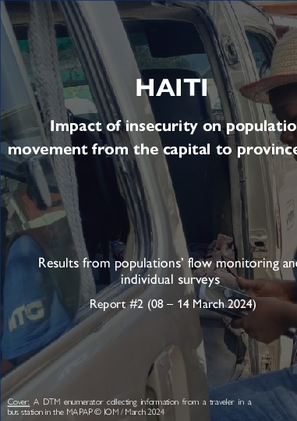
Contact
DTM Haiti, dtmhaiti@iom.int
Language
English
Location
Haiti
Period Covered
Mar 08 2024
Mar 14 2024
Activity
- Survey
- Flow Monitoring Survey
- Flow Monitoring
Since 29 February 2024, several neighborhoods in the Metropolitan Area of Port-au-Prince (MAPAP), the capital of Haiti, have been targeted by increased armed attacks. Nearly 15,000 people were displaced following these attacks (see ETT 39.1). In addition to creating displacement within the MAPAP, attacks and generalized insecurity are pushing more and more people to leave the capital to find refuge in provinces, taking the risks of passing through gangs-controlled routes. In order to monitor these movements towards provinces and inform appropriate response strategies, DTM has launched data collection at several of the most used bus stations in the capital (see page 5 for more details on the methodology). Since the start of this activity, on 8 March, until 14 March, this activity allowed to observe the movements of 16,947 people leaving the MAPAP (see pages 3 and 4 for more details on the profile of these people ). The majority of them (60%) took means of transport heading towards the Grand Sud departments (Grande’Anse, South, Nippes and South-East). It should be noted that this region already hosts more than 116,000 people who had in vast majority, fled the MAPAP in recent months (see the report on displacement in the Grand Sud).
Individual interviews with a sample indicated that 83% of people left the MAPAP because of violence and insecurity. 76% were already internally displaced before leaving the MAPAP. 96% intend to stay in the provinces in Haiti, 3% to leave for the Dominican Republic and less than 1% for the United States and Brazil.
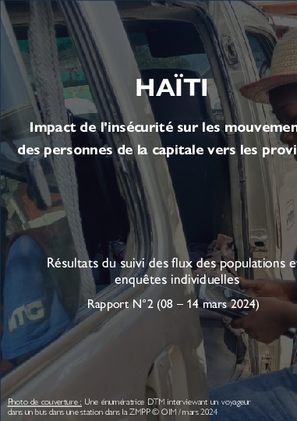
Contact
DTM Haiti, dtmhaiti@iom.int
Language
French
Location
Haiti
Period Covered
Mar 08 2024
Mar 14 2024
Activity
- Survey
- Flow Monitoring Survey
- Flow Monitoring
Depuis le 29 février 2024, plusieurs quartiers de la Zone Métropolitaine de Port-au-Prince (ZMPP), la capitale d’Haïti, sont ciblés par des attaques armées accrues. Près de 15 000 personnes se sont déplacées suite à ces attaques (voir le ETT 39.1). En plus de créer des déplacements à l’intérieur de la ZMPP, ces attaques poussent de plus en plus de personnes à quitter la capitale pour trouver refuge dans les provinces, en prenant les risques de passer par des routes contrôlées par des gangs. Afin de suivre ces mouvements vers les provinces et informer les stratégies de réponse adéquates, la DTM a lancé des collectes de données au niveau de plusieurs stations de bus les plus utilisées dans la capitale (voir la page 4 pour plus de détails sur la méthodologie). Depuis le début de cette activité, le 08 mars, jusqu’au 14 mars, cette activité a permis d’observer les mouvements de16 947 personnes quittant la ZMPP (voir les pages 3 et 4 pour plus de détails sur le profil de ces personnes). Ces personnes ont en majorité (60%) pris des moyens de transport se dirigeant vers les départements du Grand Sud (Grande’Anse, Sud, Nippes et Sud-Est). Il est à souligner que cette région accueille déjà plus 116 000 personnes qui avaient en grande partie fui la ZMPP durant des mois passés (voir le rapport sur les déplacements dans le Grand Sud).
Les interviews individuelles avec un échantillon ont indiqué que 83% des personnes quittaient la ZMPP à cause des violences et l'insécurité. 76% étaient déjà déplacées internes avant de quitter la ZMPP. 96% ont l'intention de rester dans les provinces en Haïti, 3% de partir vers la République Dominicaine et moins de 1% vers les Etats-Unis et le Brésil
Mjesečni pregled:
- Dolasci na Zapadni Balkan
- Tri najzastupljenije nacionalnosti u izvještajnom mjesecu
- Prisustvo migranata u prihvatnim centrima
- Potpomognuti dobrovoljni povratak i reintegracija
Месечен преглед на:
- Пристигнувања во Западен Балкан
- Топ три националности на лица кои пристигнале во месецот на известување
- Присуство на мигранти во прифатните објекти
Доброволно асистирано враќање и реинтеграција
Përmbledhje mujore të:
- Arritjet në Ballkanin Perëndimor
- Tre kombësitë kryesore të arriturëve
- Prania e migrantëve në qendrat pritëse
- Kthimet vullnetare dhe të asistuara
Pagination
- Previous page
- Page 21
- Next page
